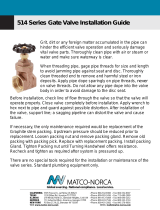
In accordance with the U.S. Safe Drinking Water Act (SDWA), it is illegal to use this product in the United States for potable water services (water intended for human consumption).
Page 1
INSTALLATION
Two piece threaded and solder end Apollo Ball valves are bi-directional. They may be
installed in vertical or horizontal pipe runs without regard to flow direction and without
regard to stem orientation.
Note: Valves must be installed in piping systems that comply with the applicable
portions of the ASME B31 standards. Special considerations must be taken with
respect to pipe line expansions and contractions and the media expansion and
contractions within the piping system.
Threaded End Valves
Mating pipe connections should be accurately threaded, clean and free of foreign
material or metal shavings. Two to four wraps of PTFE pipe tape (or pipe dope, but not
both) should be applied to the male threads. Two wrenches must be used when mating
up pipe joints to these valves. Apply one flat-faced wrench on the valve hex closest to
the pipe joint being tightened and use a pipe wrench on the pipe to prevent transmitting
torque through the valve body joint. Typical wrench make-up is 1-1/2 turns after
installing the pipe hand-tight. Do not overtighten the valve onto the pipe, as this can
damage or distort the valve. Do not reverse-rotate after tightening as this can damage
the body/retainer seal.
Solder End (Sweat In) Valves
Caution: Use only solders with melt points below 500°F.
Caution: Valves should only be soldered in the fully open or closed position.
During soldering, the mid-portion of the valve body should not exceed 300°F. This can
be monitored using Tempilstik® or an infra-red temperature sensor. Depending on the
fuel selected and the orientation of the installation it may be necessary to wrap the
valve body with wet rags or employ other heat absorbing techniques. Select a torch tip
size appropriate for the tube size being soldered. The flame must be directed away
from the valve body, concentrated on the solder cup. The cup should be heated evenly.
Allow heated joints to cool naturally. Quenching with water will cause unnecessary
stress on the joint.
Fuel Flame temp w/Oxygen
Propane 3596°F (1980°C)
Natural Gas 3560°F (1960°C)
MAPP Gas 3670°F (2021°C)
Acetylene 4622°F (2550°C)
Warning: Excessive heat input will damage the body seal resulting in leaks at the valve
body joint. In extreme cases, seats and stem packing may also be damaged.
OPERATION
The valve handle is marked showing proper “FLOW” direction in respect to lever
position at extreme end of lever travel.
INLET
LEVER POSITION
0° 45° 90°
Page 2
MAINTENANCE
Regular Maintenance
Normal stem packing wear can be compensated for by tightening the packing gland
screw. (Wrench part number H371400 is available to ease this operation.) Tighten the
packing gland screw clockwise in 1/8 turn increments until observed leakage stops. If
all of the adjustments to the packing gland screw have been made, remove the handle
nut, handle and packing gland screw and add one or two replacements bearings on top
of the old packing. Reinstall the handle and handle nut.
Caution: Do not disassemble valve while under pressure nor with entrapped hazardous
fluids therein.
Valve Repair
Disassembly
1) Operate the valve 0° to 90° to assure there are no trapped fluids or pressure in
the body cavity. Place the handle in the position such that is parallel to the
inlet port.
2) Remove the handle nut, handle and packing nut. Set aside for reuse.
3) Install pipe plugs in the body and retainer ports of NPT valves to prevent
collapsing those areas.
4) Remove the retainer from the body. It may be necessary to heat the body joint
above 450°F to breakdown the sealant used to secure the valve halves.
5) Remove the ball from the body cavity. Inspect the ball. If it is scarred, it is
recommended that the whole valve be replaced, but replacement balls are
available. Clean and set aside good balls for reuse.
6) Push the stem from the outside into the body cavity. Inspect the stem. If it is
scarred or has damaged threads, replacements are available. Clean and set
aside good stems for reuse.
7) Remove all seals and seats from the body and retainer then discard. Inspect
the body and retainer for damage. If damaged, scrap the valve as
replacements of these components are not offered.
Note: Union end valves cannot be easily repaired; therefore it is recommended
that the main valve section be replaced.
Re-Assembly
1) Install stem bearing on to stem.
2) Fit stem into body from the retainer end and position the stem with the handle
flats perpendicular to the flow axis.
3) Install stem packing over stem and fit into body recess.
4) Install packing gland screw into the threaded stem area.
5) Tighten the gland screw to manufacturing torque specifications: Contact
factory for torque values.
6) Install the handle and handle retaining hardware.
7) Apply suitable light lubricant to seat and fit into the seat pocket of the body.
8) Install the ball. Make sure that the handle is parallel to the inlet port.
9) Apply suitable light lubricant to seat and fit into the seat pocket of the retainer.
10) Apply an adequate amount of thread locking compound (Loctite 609, 648 or
680) to the retainer threads. Enough to cover no less than two complete
threads shall be applied to the leading threads opposite the retainer shoulder.
Note: Valves in oxygen service can only be sealed with oxygen compatible thread sealant.






